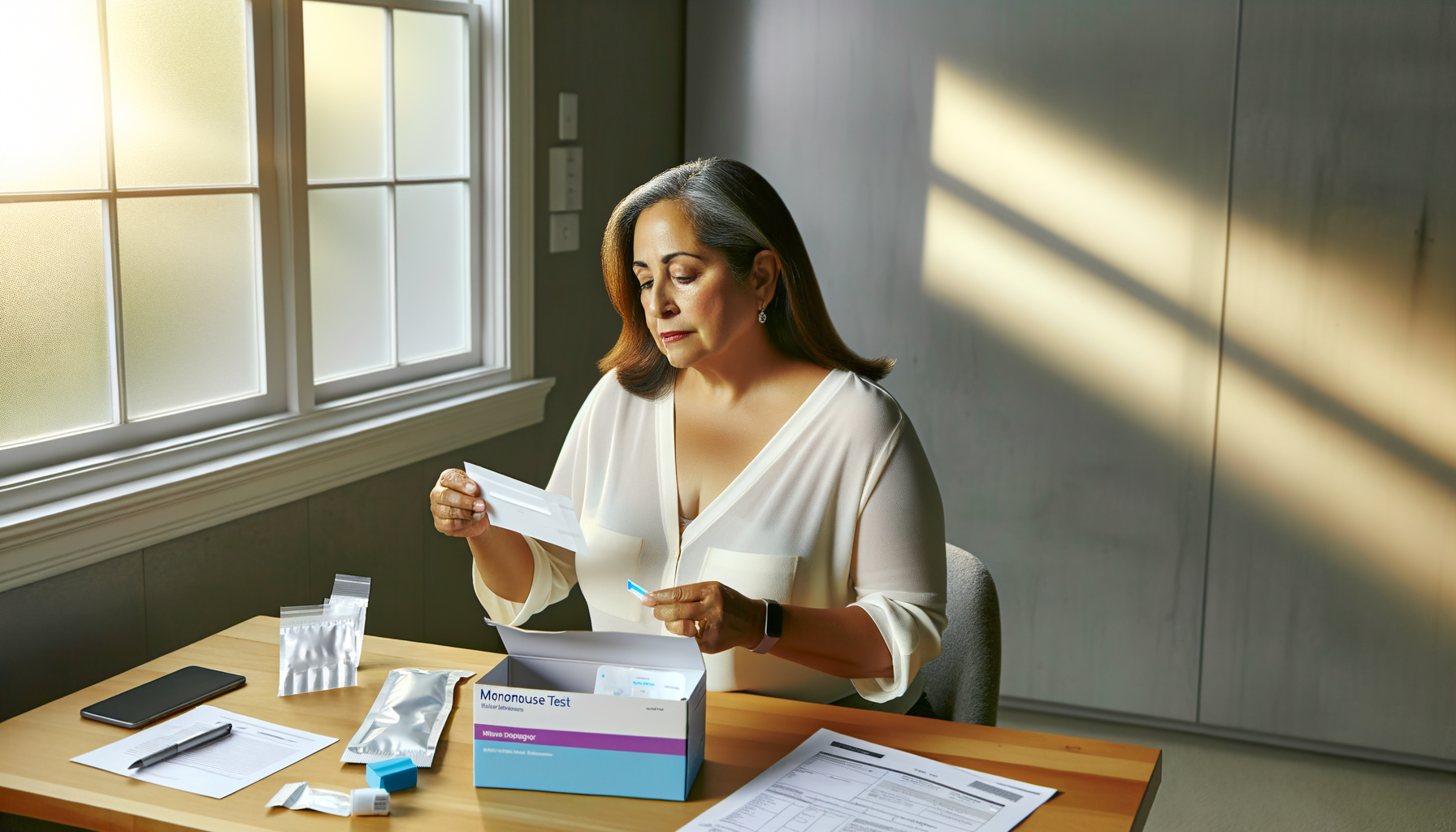Menopause and Its Diagnosis
Menopause marks a significant transition in a woman’s life, typically occurring in the 40s or 50s, with the average age in the United States being 51. It is defined as the cessation of menstrual cycles for 12 consecutive months and signifies the end of a woman’s reproductive years. The period leading up to menopause, known as perimenopause, involves a variety of changes in the menstrual cycle and the onset of symptoms such as hot flashes and mood swings. This phase can last for several years and is characterized by fluctuations in the frequency and duration of menstrual periods.
The Role of Hormones in Menopause
Hormones play a central role in the menopausal transition. As women age, the ovaries produce less estrogen and progesterone, hormones that are crucial for regulating menstruation and fertility. The decline in these hormones leads to the changes experienced during perimenopause and menopause. Estrogen levels, in particular, have a profound impact on various bodily functions, and their reduction is responsible for many of the symptoms associated with menopause.
Traditional Diagnosis vs. At-Home Testing
Traditionally, menopause has been diagnosed clinically, based on a woman’s symptoms and the absence of menstruation for one year. Healthcare providers may also run blood or urine tests to measure hormone levels, such as estradiol, follicle-stimulating hormone (FSH), and luteinizing hormone (LH), to provide additional information. However, hormone levels can fluctuate significantly, making a single test unreliable for diagnosing menopause.
The Emergence of Home Menopause Tests
In recent years, home menopause tests have emerged as a convenient option for women seeking to understand their menopausal status. These tests typically measure FSH levels in urine to provide an indication of the hormonal changes associated with menopause. While they offer privacy and convenience, the accuracy and reliability of these tests can vary, and they should not replace professional medical advice. It is important for women considering these tests to understand their limitations and to consult with healthcare professionals for a comprehensive assessment.
How Home Menopause Tests Work
The Science Behind the Tests
Home menopause tests are designed to measure hormone levels associated with the transition into menopause. These tests typically focus on key hormones such as follicle-stimulating hormone (FSH), estradiol, and luteinizing hormone (LH). FSH is released by the pituitary gland and is involved in regulating the menstrual cycle and egg development. As menopause approaches, FSH levels typically rise due to decreased estrogen production. Estradiol, a form of estrogen, prepares the uterine lining for egg implantation and decreases after menopause. LH assists in releasing eggs from the ovaries, and its levels can increase during menopause. These hormonal changes are the biomarkers that home tests aim to detect.
Collection Methods: Blood, Saliva, and Others
Home menopause tests employ various sample collection methods, including:
- Blood: Often collected via a finger prick, blood samples can measure levels of FSH, estradiol, and LH.
- Saliva: Some tests require a saliva sample to assess hormone levels, which may be preferable for those uncomfortable with blood collection.
- Urine: Urine tests measure FSH and can provide insights into menopausal stages when used over several days.
These samples are then mailed to a laboratory for analysis, with pre-paid shipping materials typically provided in the test kit.
Understanding the Results
After laboratory analysis, customers receive personalized reports detailing their hormone levels. Elevated FSH levels, for example, may indicate that a person is approaching menopause. However, it’s important to note that hormone levels can fluctuate, and a single test may not provide a definitive answer. Results are often available online within a few days to a week, depending on the test provider.
Consultations and Doctor Reviews
Many home menopause test providers offer additional support, such as consultations with healthcare professionals. For instance, some companies provide free consultations with doctors if results suggest perimenopause. Independent board-certified doctors often review the test results, ensuring a professional assessment. Customers are encouraged to discuss their results with their own doctors to determine the best course of action based on their individual health needs.
Evaluating the Effectiveness of Home Menopause Tests
Accuracy and Reliability Concerns
When considering home menopause tests, a primary concern for many is the accuracy and reliability of the results. These tests typically measure hormone levels such as follicle-stimulating hormone (FSH), estradiol, and luteinizing hormone (LH), which are indicators of menopausal status. However, hormone levels can fluctuate significantly, making it challenging to pinpoint menopause, especially during the perimenopausal phase. Additionally, factors such as the timing of the test in relation to menstrual cycles and the influence of certain medications can impact results. It is crucial for users to follow the test instructions meticulously and be aware that these tests are not a definitive diagnosis but rather a tool to provide insights into hormonal changes.
Certifications and Lab Standards
Home menopause tests often tout their use of CLIA-certified laboratories, which is a critical factor in ensuring the quality and reliability of test results. CLIA certification indicates that the labs adhere to high standards of accuracy, reliability, and timeliness of patient test results. Moreover, some companies have their results reviewed by independent board-certified doctors, adding an additional layer of credibility. While these certifications are reassuring, it is important to recognize that they do not guarantee the tests’ ability to diagnose menopause definitively.
Comparison with Clinical Tests
Comparing home menopause tests to clinical tests is essential in evaluating their effectiveness. Clinical tests conducted by healthcare professionals consider a broader range of factors, including a patient’s symptoms, medical history, and family history. While home tests offer convenience and privacy, they should not replace a comprehensive evaluation by a doctor. If a home test suggests the possibility of menopause, it is advisable to follow up with a healthcare provider for a more thorough assessment and confirmation.
User Experiences and Testimonials
User experiences and testimonials can provide valuable insights into the practical aspects of home menopause tests. Many users appreciate the convenience, speed, and privacy of testing at home. Positive testimonials often highlight the ease of use, clear instructions, and the benefit of having results reviewed by healthcare professionals. However, some users report challenges, such as the cost of the tests, limited availability in certain regions, and the anxiety of interpreting results without direct medical guidance. It is important for potential users to consider both the positive and negative feedback to make an informed decision about whether home menopause testing is right for them.
Pros and Cons of Different Test Types
Benefits of Using Home Menopause Tests
Home menopause tests offer several advantages for individuals navigating the transition into menopause. Firstly, they provide convenience and privacy, as samples can be collected in the comfort of one’s home. These tests are also non-invasive, with simple collection methods such as finger pricks or saliva samples. The speed of results is another benefit, with some tests delivering results within a few days, allowing for quick insights into hormonal changes.
Moreover, many home tests are associated with CLIA-certified labs, ensuring a high standard of accuracy and reliability. Some tests also offer additional support, such as consultations with healthcare professionals, which can be invaluable for interpreting results and planning next steps. The ease of use is highlighted by clear instructions and provided collection tools, making the process straightforward for users.
Limitations and Drawbacks
Despite their benefits, home menopause tests have limitations. One significant concern is the cost, as these tests can be expensive, with prices often exceeding $90. Additionally, they may not be covered by health insurance, which could make them less accessible for some individuals. Another drawback is the lack of comprehensive analysis compared to clinical tests, as home tests may not measure all relevant hormones.
There are also availability issues, with some tests not being accessible in certain states or countries. The requirement for self-collection of samples may also lead to errors, potentially affecting the accuracy of results. Furthermore, while some tests offer doctor consultations, others do not, which could leave users with questions about their results.
Cost Analysis and Value
When considering the value of home menopause tests, it’s important to weigh the cost against the benefits received. While the upfront cost may seem high, these tests can offer quick and convenient insights into hormonal status, which may be worth the investment for those seeking immediate information. Some companies also offer subscriptions for regular testing, which can provide savings over time.
However, it’s crucial to consider that these tests are generally not a substitute for professional medical advice. Users should be prepared to potentially seek further testing or consultations with healthcare providers, which could incur additional costs.
Accessibility and Availability Issues
Accessibility is a key concern with home menopause tests. Some tests are not available in certain regions, such as New York or outside the United States, which limits who can use them. Shipping delays may also impact the timeliness of receiving results. Moreover, the need for internet access to register and receive results can be a barrier for some individuals.
It’s also worth noting that while home tests can be a valuable tool for those living in areas with limited healthcare services, they should not replace regular check-ups and consultations with healthcare professionals. The importance of professional guidance cannot be overstated, especially for managing symptoms and receiving personalized care.
Considerations Before Purchasing Home Menopause Tests
Identifying Personal Needs and Goals
Before investing in a home menopause test, it’s crucial to reflect on your personal health goals and reasons for testing. Are you seeking confirmation of perimenopause or menopause due to symptoms you’re experiencing, or are you curious about your hormonal health as you approach a certain age? Understanding your motivations will guide you in selecting a test that aligns with your needs, whether it’s a basic FSH level check or a more comprehensive hormone panel.
Assessing Hormonal Health and Symptoms
Menopause and its precursor, perimenopause, can present a variety of symptoms, such as hot flashes, night sweats, and irregular periods. If you’re experiencing these changes, a home menopause test can offer insights into your hormonal levels. However, it’s important to note that hormone levels, particularly FSH, can fluctuate. A single test may not provide a definitive answer, and symptoms alone cannot confirm menopause. Therefore, consider tracking your symptoms over time and be prepared to possibly test multiple times if needed.
Consulting Healthcare Professionals
While home menopause tests can be convenient, they are not a substitute for professional medical advice. Before purchasing a test, it’s advisable to consult with a healthcare professional. They can provide guidance on whether a home test is appropriate for your situation and help interpret the results within the context of your overall health and medical history. Additionally, some conditions may mimic menopausal symptoms, so a healthcare provider can rule out other potential causes.
Reviewing Test Kit Components and Ease of Use
When considering a home menopause test, review the kit’s components and instructions to ensure ease of use. Look for clear, step-by-step guidance on how to collect the sample, whether it’s a finger prick, saliva, or urine test. Check if the kit includes all necessary materials, such as collection tubes, biohazard bags, and prepaid shipping labels. Also, consider the method of result delivery and whether the test offers additional support, like consultations with healthcare professionals, which can be invaluable in understanding your results.
Remember: Home menopause tests are tools that can provide helpful information about your hormonal status, but they should be used in conjunction with professional medical advice. By carefully considering your personal needs, assessing your symptoms, consulting with healthcare professionals, and reviewing the test kit’s components and ease of use, you can make an informed decision about whether a home menopause test is right for you.

From unhappy, dry, and sandpaper to silky, smooth and feeling good. That’s Cleo. Cleo is a 100% natural labial balm to moisture and soothe “your other lips”. Cleo is chemical-free, water-free, pH optimized and helps maintain and restore your delicate labial skin’s natural flora. Ideal for daily use or as needed. Get the most silky, lovable lips ever.
The Future of Menopause Testing
Technological Advancements in Hormone Testing
As we look to the future, technological advancements are set to revolutionize the way hormone testing is conducted. Innovations in biosensor technology and machine learning algorithms are expected to enhance the precision of hormone level detection. This could lead to the development of real-time hormone monitoring devices, providing continuous feedback and allowing for more personalized and responsive management of menopausal symptoms.
Integrating Home Testing with Telehealth
The integration of home testing with telehealth services is a promising trend that could expand access to menopause management. With the rise of telemedicine, individuals undergoing menopause could perform tests at home and instantly share results with healthcare providers via digital platforms. This approach not only streamlines the consultation process but also ensures timely medical advice, potentially improving treatment outcomes.
Potential Developments in Early Menopause Detection
Early detection of menopause can be crucial for mitigating long-term health risks associated with hormonal changes. Research is underway to identify novel biomarkers and genetic predispositions that could predict the onset of menopause. Such developments could lead to predictive testing models that inform individuals of their menopausal timeline, allowing for proactive health planning and interventions.
Improving Accessibility and Reducing Costs
One of the primary goals for the future of menopause testing is to improve accessibility and reduce costs. Efforts are being made to lower the price point of testing kits and increase their availability, particularly in underserved communities. Additionally, insurance coverage for menopause testing is a critical area that needs attention, as broader coverage would make these essential health tools more accessible to a wider population.
In conclusion, the future of menopause testing is poised to offer more accurate, accessible, and affordable options for individuals navigating this natural life transition. With ongoing research and innovation, we can expect to see a new era of personalized care that empowers individuals to manage their menopausal health with confidence and support.
Conclusion and Recommendations
Summarizing the Efficacy of Home Menopause Tests
Home menopause tests have emerged as a convenient tool for women seeking to understand their menopausal status. These tests typically measure levels of Follicle-Stimulating Hormone (FSH) in urine, providing an indication of the hormonal changes associated with menopause. While they offer a degree of privacy and immediacy, the efficacy of these tests can be variable. Hormone levels during perimenopause can fluctuate significantly, which may lead to false positives or negatives. Therefore, while home menopause tests can be a useful starting point, they should not be solely relied upon for a definitive diagnosis. It is essential for women to follow up with healthcare professionals for a comprehensive evaluation.
Final Thoughts on Choosing the Right Test
When considering menopause testing, the choice between traditional clinical tests and at-home options depends on individual circumstances. Clinical tests, conducted under the guidance of healthcare providers, can offer a more accurate assessment due to the ability to conduct multiple tests over time and interpret results in the context of a patient’s overall health. However, for those seeking a preliminary assessment, home menopause tests can be a practical choice. It is crucial to recognize that these tests are part of a broader diagnostic process that includes symptom tracking, medical history, and possibly further hormonal evaluations.
Encouraging Further Research and Consultation
Given the complexities of diagnosing menopause, ongoing research into more accurate and accessible testing methods is vital. Women are encouraged to stay informed about the latest developments in menopause testing and to engage in open dialogue with healthcare professionals. Consulting with a doctor or a menopause specialist can provide clarity, ensure that other health conditions are not overlooked, and lead to effective management strategies for menopausal symptoms. Ultimately, a proactive approach to health during the menopausal transition can significantly improve quality of life.


















